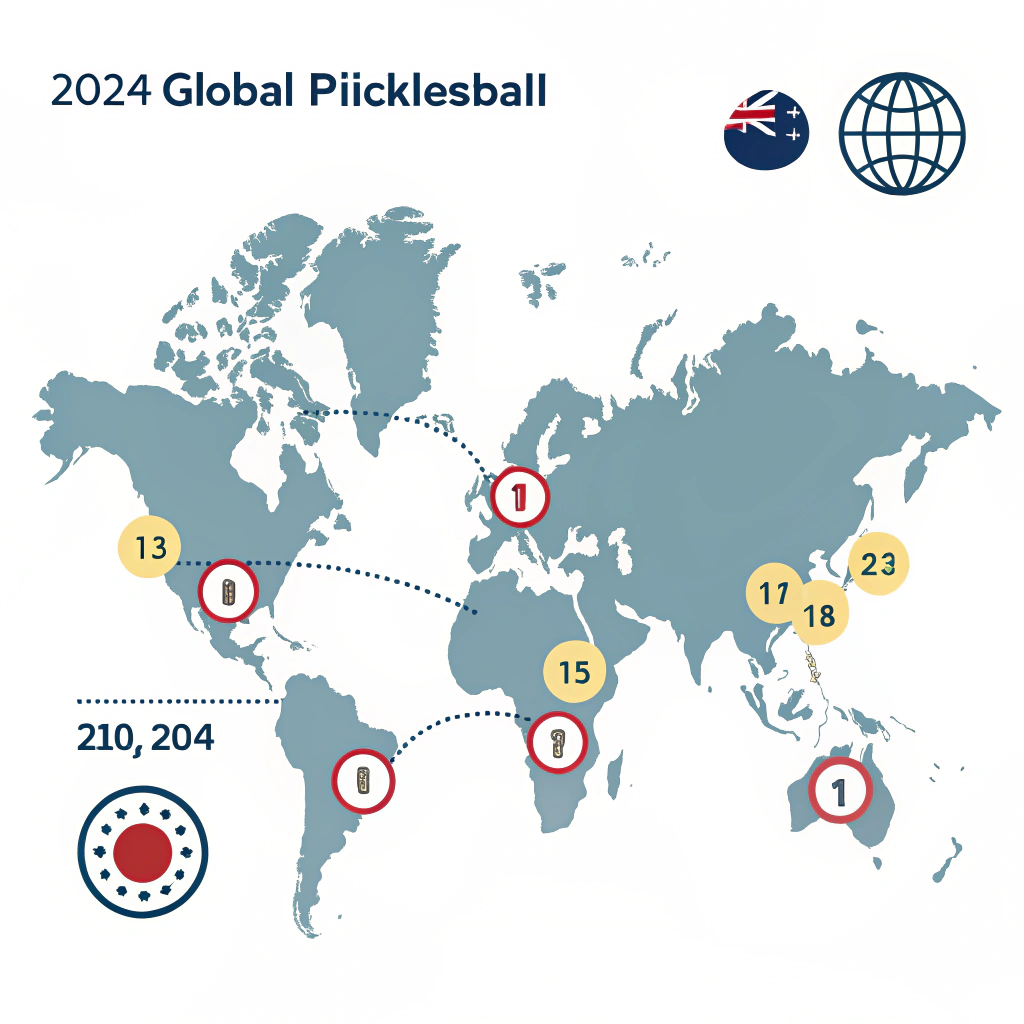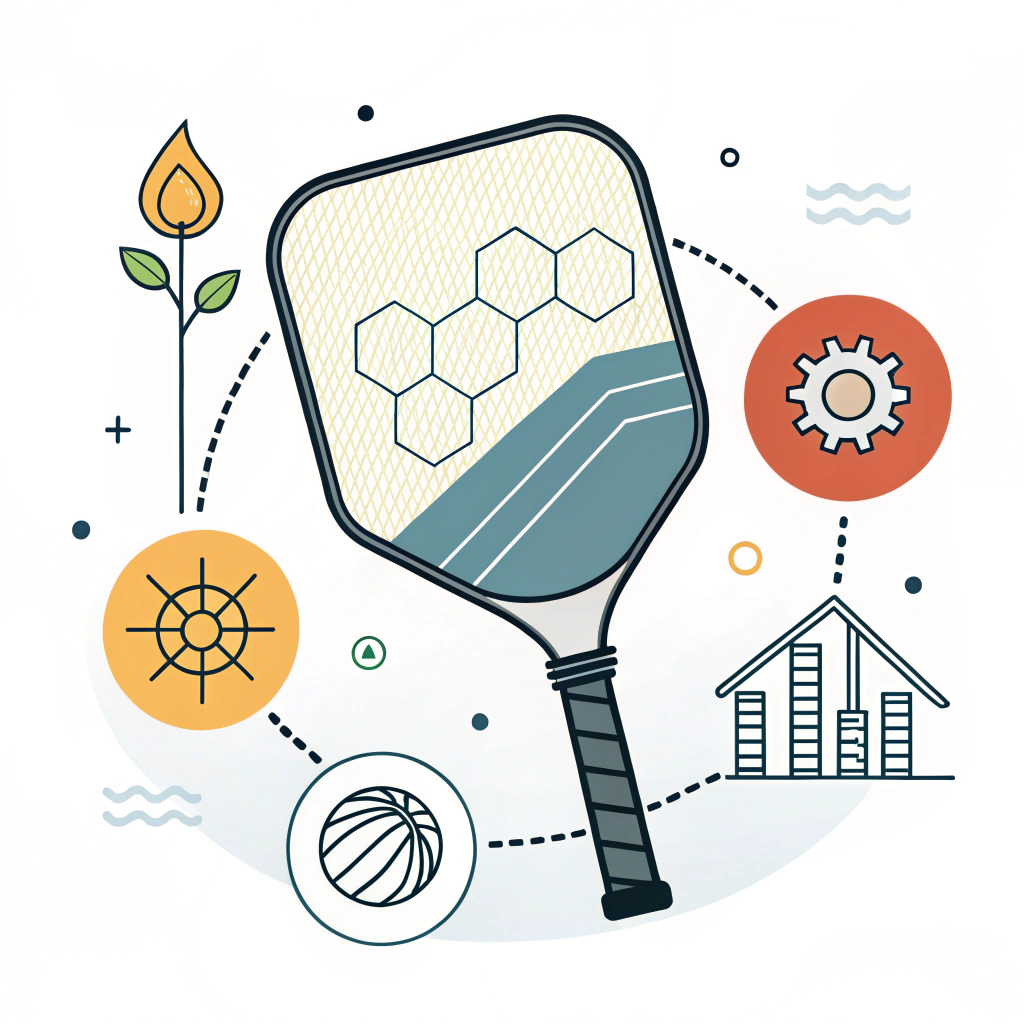Pickleball’s journey from a simple backyard game to a global sports phenomenon demonstrates how sports can evolve into lucrative markets through accessibility, simplicity, and continuous innovation.
Pickleball was originally invented in the mid-1960s in the United States. Over the decades, it has evolved from a casual pastime into a professional sport with immense market potential. In this article, we will explore the historical origins of pickleball, analyze the factors that have fueled its global growth, and assess the opportunities and challenges this evolution poses for B2B decision-makers in the sports equipment industry.
Pickleball was created out of necessity and creativity. In 1965, a group of friends in Washington state invented the game to entertain themselves during family gatherings, using simple equipment that included a paddle and a perforated ball. Thanks to its simplicity and ease of learning, the game quickly became popular among people of all ages. Here are some key milestones:
- 1965: The game is invented, blending elements of tennis, badminton, and ping-pong.
- 1972: The first official pickleball tournament is held, setting the stage for a more structured competitive environment.
- 1980s: Community centers and local clubs begin incorporating pickleball into their recreational programs.
- 2000s: The sport experiences a significant surge as organized clubs, leagues, and tournaments form, particularly in the United States.
This rapid adoption created initial market opportunities for manufacturers of sports equipment that either adapted existing materials or began developing custom-made paddles to suit the game’s unique demands.
In recent years, pickleball has seen surge in international interest. Initially dominated by the United States—with over 3 million players—the sport has steadily captured the attention of players and enthusiasts in countries like Canada, Mexico, and various European nations. A few factors have contributed to this expansion:
- Accessibility: The relatively low cost of entry – needing only a paddle and a perforated ball – has made it accessible to a wide range of demographics.
- Simple Rules: With minimal learning curves, even beginners can quickly grasp the game, leading to rapid adoption in community sports programs.
- Health and Social Benefits: As people seek enjoyable physical activities that offer both exercise and social engagement, pickleball presents an attractive option.
These factors have led to the development of robust distribution channels, targeted marketing campaigns, and a broad interest in high-performance equipment, especially from companies like NEX Pickleball. Our company leverages advanced production techniques using premium materials such as 3K Carbon Fiber1, fiberglass, and specialized composites to create paddles that cater to both competitive players and recreational enthusiasts.
Below is a table summarizing key data points associated with global pickleball market growth over recent years:
| Region | Estimated Players | Annual Growth Rate | Key Market Drivers |
|---|---|---|---|
| North America | 3+ million | 10-15% | Community programs, competitive leagues |
| Canada | 500,000+ | 12-14% | Increasing recreational facilities |
| Europe | 200,000+ | 8-10% | Rising interest in leisure and fitness sports |
| Latin America | 150,000+ | 9-11% | Government support for grassroots sports |
This data illustrates a clear upward trajectory in both player participation and market demand. B2B decision-makers, particularly procurement managers and distributors, should note how these trends directly impact the sports equipment industry's dynamics.
The success of pickleball is not accidental. Several fundamental factors have driven its transition from a regional game to a global trend:
The minimalistic nature of pickleball equipment has been one of its strongest advantages. Unlike sports that require complex or expensive gear, pickleball requires just a paddle and a ball. However, within this simplicity lies a world of technological innovation.
- Material Advancements: Innovations in materials—such as the integration of 3K Carbon Fiber1, 12K Carbon Fiber, and T300 Carbon Fiber—offer enhanced strength, durability, and performance. These materials have allowed manufacturers to produce paddles that cater to both power and precision.
- Production Techniques: Modern production methods such as hot pressing, cold pressing, and thermoforming2 allow for precise control of paddle shape, weight distribution, and surface finish. These processes ensure that each paddle can be tailored to meet specific performance criteria, thus broadening consumer choice.
The rules of pickleball are easy to learn, making the sport particularly popular among beginners and casual players. This simplicity has driven rapid adoption in various settings, from retirement communities to youth sports programs. As more communities invest in pickleball courts and clubs, the demand for high-quality paddles increases, fueling further market growth.
In an era where health and wellness play a critical role in daily life, pickleball offers several health benefits without requiring intense physical strain. Its moderate pace and minimal risk of injury have made it a favored choice for people looking to stay active. Additionally, the sport encourages social interaction, which is appealing in both recreational and corporate wellness programs.
While the United States remains the largest market, other regions are experiencing rapid growth. In Canada and Mexico, professional leagues and community tournaments are becoming common. European countries are steadily entering the market as well, drawn by the sport's low cost and high fun factor. This global spread offers various opportunities for multinational distributors and sporting goods companies to expand their portfolios.
For B2B buyers, understanding how manufacturers differentiate their products is crucial. NEX Pickleball has established itself as a leader in this domain by continually innovating the design and production processes. Here are some of the innovative aspects that set high-performance pickleball paddles apart:
Many modern pickleball paddles incorporate a mix of materials to optimize different performance aspects:
- Composite Materials3: Combining carbon fiber with fiberglass delivers a balance of control and power. For example, the Carbon Fiber and Fiberglass Composite paddle is increasingly sought after for its ability to reduce vibration and increase responsiveness.
- Core Technologies: The choice of core material is critical. Options such as Nomex Honeycomb4, Aluminum Honeycomb, and Polymer Honeycomb cores provide a mix of durability, elasticity, and strength. Each type caters to distinct player needs—from recreational comfort to competitive precision.
The three primary manufacturing techniques used to produce pickleball paddles each have unique benefits:
| Production Process | Advantages | Disadvantages |
|---|---|---|
| Hot Pressing | High production volume; strong, durable paddles | Can alter material feel; high equipment cost |
| Cold Pressing | Precise control over thickness; excellent ball feel | Longer production cycle |
| Thermoforming | Complex design capabilities; precise material control | Higher equipment cost; longer production time |
These processes ensure that each paddle delivers the optimal balance of power, control, and durability, catering to diverse market demands.
For B2B decision-makers in the sports equipment industry, the evolution of pickleball represents both a challenge and an opportunity. Here are several considerations for businesses aiming to tap into this growing market:
Companies should invest in research and development to keep pace with technological advancements in paddle manufacturing. As consumer expectations evolve, incorporating high-performance materials and advanced production methods will be key to maintaining a competitive edge.
Given the sport’s broad appeal—from recreational players to serious competitors—segmenting the market and offering customized solutions can yield dividends. Many businesses are already offering bespoke paddle designs tailored to specific performance needs, branding opportunities, or promotional events.
B2B buyers should leverage market data and industry reports to make informed purchasing decisions. Analyze regional data trends, such as the growth rate in North America versus emerging markets like Europe and Latin America, to allocate resources efficiently. Developing partnerships with data analytics firms can further refine market strategies, ensuring that product portfolios align with current trends.
As pickleball continues to gain international traction, building robust distribution networks is essential. Collaborations or partnerships with leading manufacturers like NEX Pickleball can offer competitive pricing, timely production, and high-quality products, all of which are critical for penetrating new markets.
Finally, businesses should consider the growing demand for personalized and on-demand products. Customization not only meets individual player needs but also opens up additional revenue streams through branded or limited-edition products. With the capability for on-demand print services on pickleball paddles, companies can quickly adapt to market trends and consumer preferences.
Pickleball’s transformation from a recreational activity to an internationally recognized sport is a clear indicator of evolving market trends in the sports equipment industry. Its history is rich with examples of innovation, community engagement, and strategic market growth. For B2B decision-makers, these developments offer valuable insights into consumer behavior and emerging business opportunities.
Businesses that invest in innovative production techniques, segment their market offerings, and build strong distribution networks will be well-positioned to take advantage of pickleball’s sustained growth. As the sport continues to expand globally, staying informed on historical developments and current market trends remains essential for successful procurement and strategic investment decisions.
By leveraging these insights, companies can ensure their product portfolios meet the increased demand for high-performance, durable, and customizable pickleball equipment. With ongoing advancements and a steadily growing global player base, the future of pickleball looks both dynamic and full of potential for those ready to capitalize on its momentum.
Q: Is pickleball growing internationally?
A: Yes, pickleball has experienced rapid international growth. While the United States remains the largest market with over 3 million players, countries like Canada, Mexico, and several European nations are quickly expanding their player bases, driven by the sport’s accessibility and community-oriented nature.
Q: What caused pickleball to become so popular?
A: Its popularity stems primarily from its accessibility and ease of learning. The simple rules, low-cost equipment, and inclusive nature of the game have made it an attractive option for both beginners and seasoned athletes, promoting rapid adoption across diverse age groups and markets.
Q: When did pickleball start to get popular?
A: Although pickleball was invented in 1965, its popularity notably surged in the 2000s with the rise of organized clubs, tournaments, and increased media exposure, particularly in the Pacific Northwest of the United States, setting the stage for its global market expansion.
-
3K Carbon Fiber: Click to explore detailed information on 3K Carbon Fiber’s properties and its role in enhancing paddle performance through improved strength and durability. ↩ ↩ ↩2
-
Thermoforming: Click to learn more about thermoforming processes, including how they enable complex design capabilities and precise material control in manufacturing. ↩ ↩
-
Composite Materials: Click to read about composite materials, their composition, and how combining materials like carbon fiber and fiberglass can enhance product performance. ↩ ↩
-
Nomex Honeycomb: Click to understand Nomex Honeycomb core technology and its benefits in terms of durability and elasticity in sports equipment manufacturing. ↩ ↩







